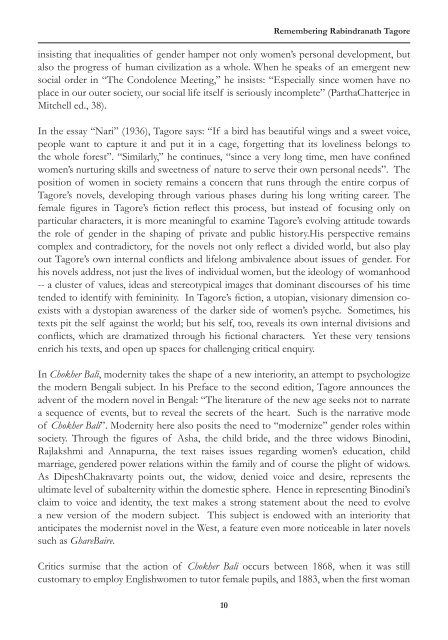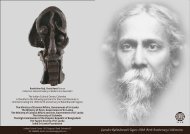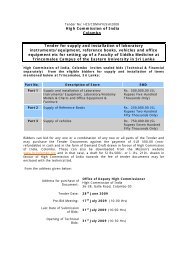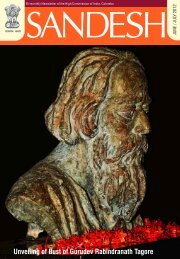Remembering Rabindranath Tagore Volume - High Commission of ...
Remembering Rabindranath Tagore Volume - High Commission of ...
Remembering Rabindranath Tagore Volume - High Commission of ...
Create successful ePaper yourself
Turn your PDF publications into a flip-book with our unique Google optimized e-Paper software.
10<br />
<strong>Remembering</strong> <strong>Rabindranath</strong> <strong>Tagore</strong><br />
insisting that inequalities <strong>of</strong> gender hamper not only women’s personal development, but<br />
also the progress <strong>of</strong> human civilization as a whole. When he speaks <strong>of</strong> an emergent new<br />
social order in “The Condolence Meeting,” he insists: “Especially since women have no<br />
place in our outer society, our social life itself is seriously incomplete” (ParthaChatterjee in<br />
Mitchell ed., 38).<br />
In the essay “Nari” (1936), <strong>Tagore</strong> says: “If a bird has beautiful wings and a sweet voice,<br />
people want to capture it and put it in a cage, forgetting that its loveliness belongs to<br />
the whole forest”. “Similarly,” he continues, “since a very long time, men have confined<br />
women’s nurturing skills and sweetness <strong>of</strong> nature to serve their own personal needs”. The<br />
position <strong>of</strong> women in society remains a concern that runs through the entire corpus <strong>of</strong><br />
<strong>Tagore</strong>’s novels, developing through various phases during his long writing career. The<br />
female figures in <strong>Tagore</strong>’s fiction reflect this process, but instead <strong>of</strong> focusing only on<br />
particular characters, it is more meaningful to examine <strong>Tagore</strong>’s evolving attitude towards<br />
the role <strong>of</strong> gender in the shaping <strong>of</strong> private and public history.His perspective remains<br />
complex and contradictory, for the novels not only reflect a divided world, but also play<br />
out <strong>Tagore</strong>’s own internal conflicts and lifelong ambivalence about issues <strong>of</strong> gender. For<br />
his novels address, not just the lives <strong>of</strong> individual women, but the ideology <strong>of</strong> womanhood<br />
-- a cluster <strong>of</strong> values, ideas and stereotypical images that dominant discourses <strong>of</strong> his time<br />
tended to identify with femininity. In <strong>Tagore</strong>’s fiction, a utopian, visionary dimension coexists<br />
with a dystopian awareness <strong>of</strong> the darker side <strong>of</strong> women’s psyche. Sometimes, his<br />
texts pit the self against the world; but his self, too, reveals its own internal divisions and<br />
conflicts, which are dramatized through his fictional characters. Yet these very tensions<br />
enrich his texts, and open up spaces for challenging critical enquiry.<br />
In Chokher Bali, modernity takes the shape <strong>of</strong> a new interiority, an attempt to psychologize<br />
the modern Bengali subject. In his Preface to the second edition, <strong>Tagore</strong> announces the<br />
advent <strong>of</strong> the modern novel in Bengal: “The literature <strong>of</strong> the new age seeks not to narrate<br />
a sequence <strong>of</strong> events, but to reveal the secrets <strong>of</strong> the heart. Such is the narrative mode<br />
<strong>of</strong> Chokher Bali”. Modernity here also posits the need to “modernize” gender roles within<br />
society. Through the figures <strong>of</strong> Asha, the child bride, and the three widows Binodini,<br />
Rajlakshmi and Annapurna, the text raises issues regarding women’s education, child<br />
marriage, gendered power relations within the family and <strong>of</strong> course the plight <strong>of</strong> widows.<br />
As DipeshChakravarty points out, the widow, denied voice and desire, represents the<br />
ultimate level <strong>of</strong> subalternity within the domestic sphere. Hence in representing Binodini’s<br />
claim to voice and identity, the text makes a strong statement about the need to evolve<br />
a new version <strong>of</strong> the modern subject. This subject is endowed with an interiority that<br />
anticipates the modernist novel in the West, a feature even more noticeable in later novels<br />
such as GhareBaire.<br />
Critics surmise that the action <strong>of</strong> Chokher Bali occurs between 1868, when it was still<br />
customary to employ Englishwomen to tutor female pupils, and 1883, when the first woman

















